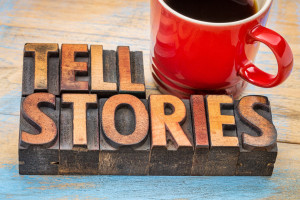 I’ve been a technology marketing copywriter for years. About a year ago I came across the concept of B2B marketing using stories. I was excited because outside of work, I’m a storyteller. I thought this will be right up my alley. I could offer storytelling techniques to my copywriting clients, which will make my work more valuable to them. Everyone will be happy.
I’ve been a technology marketing copywriter for years. About a year ago I came across the concept of B2B marketing using stories. I was excited because outside of work, I’m a storyteller. I thought this will be right up my alley. I could offer storytelling techniques to my copywriting clients, which will make my work more valuable to them. Everyone will be happy.
But when I started to study B2B storytelling, I got more and more confused. It wasn’t the confusion that occurs at the start of a learning curve, because I knew storytelling. My problem was that the people who were teaching storytelling for B2B didn’t seem to be teaching storytelling. The method didn’t fit the storytelling archetypes, they didn’t have any story structure, they lacked any emotional touch points, and “hero journey” that they were talking about wasn’t the classical hero journey at all. As I got more confused, I got irritated.
Beyond the Video
It wasn’t all as black-and-white as that. Stories clearly fit well in in video. The more successful storytelling video tended to be high production collateral. Scripting and filming quality video is not a cheap ticket item, and you would usually see companies like Apple, GE, and Intel spending big resources to make them.
I concluded that most of my clients—midsize companies and divisions of larger companies–won’t be able to produce an award-winning video, so forget telling stories in content marketing. (The only exception I could see was the case study, which is already a story.) I did not look back for quite a while.
Recently I took another look and I’m glad I did. The idea of storytelling in B2B marketing has started to mature from thinking video-only and link bait articles about the “hero journey.”
I began to think about what kind of story works in B2B content marketing. The case study sure, but what about white papers, blogs, e-books, and articles? Because so much of content marketing is feeding the beast. You need to produce a lot of content to get the kind of attention that you want. It needs to be quality content and you want to be able to leverage it. And you don’t want to write the same generic content that your competitors keep churning out. How can story help in this context?
Story helps you stand out because it’s a fundamental part of being human. Human beings tell stories to themselves and to each other. And because story already holds such a fundamental place in the human conscience, in marketing communications a little goes a long way.
Let’s take the most obvious type of story-related content, customer success stories. Their challenge is:
- So many vendors are doing them that customers are getting weary of reading them. Don’t get me wrong — customers generally respond positively to case studies — but you need to rise above the average to get the attention you need.
- Many case studies are poorly written. The traditional format of challenge / search / solution / benefit is all right; you don’t need to stray far from it. Nor do you want to come across as whimsical or emotional. But you do need to make your case study a rich reading experience by adding elements of good stories. Make the customer quotes accurate and interesting, choose rich wording, use active verbs. Et voilà, you have a compelling and accurate customer story built on subtle story elements.
Example: Enlivening the Basic Case Study
Let’s look at an example of a case study from a major storage vendor. The idea is good — a major enterprise shares their success with the vendor’s products. But the case study is full of jargon and stilted quotes, which diminishes its impact… in plain English, it’s boring. I took a section of the case study and compared the actual writing with my suggested revision paragraph-by-paragraph.
Original: “[Company] recognized that running its own data center—with all of its cooling systems, redundant power supplies, generators and other continuity measures—was inefficient in an age when service providers can offer higher service levels and lower costs thanks to their greater economies of scale.
Revised: “[Company] discovered that running its own data center cost them a lot more than they were willing to pay. Cooling systems, redundant power supplies, generators, business continuity: costs spiraled higher year after year with no sign of slowing down. They decided to seriously look at service providers, whose greater economies of scale let them offer higher service levels at lower cost.
Original: After successfully moving to a co-located facility, the IT department was able to increase its focus on delivering greater value to the business through improved integration and performance.
Revised: The IT department’s successful search replaced their resource-consuming data center with a state-of-the-art hosted environment. The change freed them to focus on their highest priority: increasing business value by improving compute integration and performance throughout the company.
Original: Any new solution needed to fit seamlessly into the company’s vision of a hybrid cloud infrastructure. As [customer] explains: “For all new application requests, we always ask: ‘Can it be run in the public cloud?’ That’s always our preferred option, because we don’t want to spend time managing things that can be run equally well by somebody else—giving us back vital resource time to spend innovating in our own business.”
Revised: The heart of the project was a hybrid cloud infrastructure, and any new application had to seamlessly integrate into the cloud. [Customer] put it this way: “When we get a new application request we always ask the same question: ‘Can we run it in the public cloud?’ We don’t want to spend our time managing things that someone else can manage equally well. We protect our time so we can spend it innovating our own business.”
I did not change any of the facts or the narrative flow. I did replace wording and sentence structure for action, richer word choice, and a more human touch. See what a difference it makes: better readability improves reader retention, which adds value and legs to your case study.





